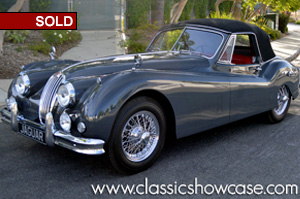1956 Jaguar XK-140 MC 3.4 DHC
Specifications |
|
| Stock: | J56-281 |
| Current condition: | SHOW |
| Performance: | 3.4-liter Jaguar XK double overhead camshaft inline-6 engine, 180 hp., 2 US carburetors |
| Transmission: | 4 speed synchromesh gearbox with electric overdrive |
| Suspension: | Front: Independent / Rear: Semi elliptical spring |
| Color exterior: | Battleship Grey |
| Color interior: | Red Interior, Black Top |
| Mileage: | 101 miles |
| Wheels: | Chrome wire wheels with spats |
| Tires: | Firestone 6.00-16 Black walls |
| Brakes: | Front and rear Disc |
| Vin #: | S818281DN |
| Engine #: | G6695-8S |
| Gearbox #: | JLE34282CR |
| Other 1: | Body Number: P4604 |

Description
(SOLD)
History
The Jaguar XK140 is a sports car manufactured by Jaguar between 1954 and 1957 as the successor to the XK120. Upgrades included more interior space, improved brakes, rack and pinion steering, increased suspension travel, and telescopic shock absorbers instead of the older lever arm design. The standard XK120 was followed up with “M” and “MC” versions (Modified and Modified, C-Type head) also known as SE in other markets. These high-performance variants boosted horsepower from the standard 160 bhp to 180 bhp and 210 bhp respectively. The XK 140 was introduced in 1954 with major changes in appearance and engineering. Externally, the classic lines were retained but were protected by sturdier bumpers to give better protection, both front and rear. From the rear, the basic lines were remained, but the finish features were completely restyled. Although the external appearance of the XK 140 was significantly altered, the major changes were mechanical. The most important change was the repositioning of the engine three inches forward on the chassis. This not only afforded additional passenger room, it also provided space for the battery in the front fender well, thus freeing the area behind the seats for a jump seat and/or additional storage.
